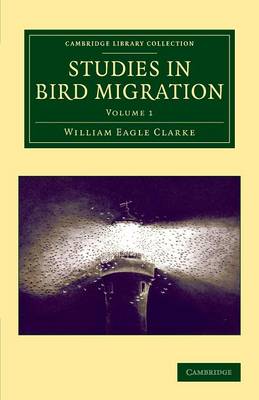Cambridge Library Collection - Zoology
3 total works
Having trained as a civil engineer and surveyor, the ornithologist William Eagle Clarke (1853–1938) established himself in his field by preparing reports on bird migration for the British Association. Focusing on the species passing through the British Isles, Clarke spent many months in various lighthouses and on remote islands. He brought all his research together in this two-volume work, first published in 1912 and illustrated with maps and weather charts. In Volume 2, Clarke describes key examples of his investigations. Photographs of the sites he visited accompany the text. The locations range from the Flannan Isles, in the Outer Hebrides, to the island of Ushant, off the coast of Brittany. Clarke's expedition to the latter location ended abruptly when he and his colleague were mistaken for spies and forced to leave. Extensive coverage is also given to Fair Isle, between Shetland and Orkney.
The ornithologist William Eagle Clarke (1853-1938) established himself in his field by preparing reports on bird migration for the British Association. Focusing on the species passing through the British Isles, Clarke spent many months in various lighthouses and on remote islands. He brought all his research together in this two-volume work, first published in 1912 and illustrated with maps, weather charts and photographs of key research locations. In Volume 1, Clarke notes which species arrive in the British Isles during each season. He also explains how weather conditions affect avian journeys, using charts to indicate temperature changes across Europe and wind conditions over Britain. The annual movements of swallows, skylarks, rooks and other species are then discussed individually. In Volume 2, Clarke describes key examples of his investigations. The locations range from the Flannan Isles, in the Outer Hebrides, to the island of Ushant, off the coast of Brittany.
Having trained as a civil engineer and surveyor, the ornithologist William Eagle Clarke (1853–1938) established himself in his field by preparing reports on bird migration for the British Association. Focusing on the species passing through the British Isles, Clarke spent many months in various lighthouses and on remote islands. He brought all his research together in this two-volume work, first published in 1912 and illustrated with maps, weather charts and photographs of key research locations. In Volume 1, Clarke notes which species arrive in the British Isles during each season. A map shows the routes they take. He also explains how weather conditions affect avian journeys, using charts to indicate temperature changes across Europe and wind conditions over Britain. The annual movements of swallows, skylarks, rooks and other species are then discussed individually. The volume closes with Clarke's account of the month he spent at the Eddystone Lighthouse.


